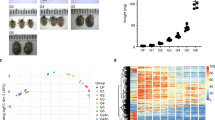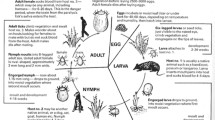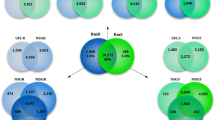Abstract
We created a cDNA library from feeding, female Ixodes scapularis ticks and screened the library with a subtracted probe to eliminate most genes common to feeding female and mating male I. scapularis ticks. Four unique genes were identified in this screen. One gene, Is 9, (represented by 16 cDNAs) was more highly expressed in female ticks. This gene encodes a putative glycine-rich protein, which matched a number of glycine-rich proteins including attachment cement proteins from Rhipicephalus appendiculatus. A second gene, Is 10 (represented by one cDNA) was also more highly expressed in female ticks, but did not match any other sequences in the GenBank database. The third gene, Is 11 (represented by one cDNA) was very similar to Drosophila sp. hsp68 and hsp70 genes and was expressed about equally in male and female ticks. The fourth gene, Is 12 (represented by two cDNAs) was also about equally expressed in male and female ticks, and was similar to a salivary gland gene from Ixodes ricinis. This gene also showed limited similarity to some cuticle genes from insects.
Similar content being viewed by others
References
Bishop R., Lambson B., Wells C., Pandit P., Osaso J., Nkonge C., Morzaria S., Musoke A. and Nene V. 2002. A cement protein of the tick Rhipicephalus appendiculatus, located in the secretory e cell granules of the type III salivary gland acini, induces strong antibody responses in cattle. Int. J. Parasitol. 32: 833–842.
Gillespie R.D., Mbow M. and Titus R. 2000. The immunomodulatory factors of bloodfeeding arthropod saliva. Parasite Immunol. 22: 319–331.
Iconomidou V., Willis J. and Hamodraks S. 1999. Is β-pleated sheet the molecular conformation which dictates formation of helicoidal cuticle? Insect Biochem. Mol. Biol. 29: 285–292.
Packila M. and Guilfoile P. 2002. Mating, male Ixodes scapularis express several genes including those with sequence similarity to immunoglobulin-binding proteins and metalloproteases. Exp. Appl. Acarol. 27: 151–160.
Paesen G., Adams P., Harlos K., Nuttall P. and Stuart D. 1999. Tick histamine-binding proteins: Isolation, cloning, and three-dimensional structure. Mol. Cell 3: 661–671.
Rebers J. and Riddiford L. 1988. Structure and expression of a Manduca sexta larval cuticle gene homologous to Drosophila cuticle genes. J. Mol. Biol. 203: 411–423.
Sonenshine D. 1991. Biology of Ticks. Vol. 1. Oxford University Press, Oxford, UK, 301 p.
Takeda M., Mita K., Quan G.-X., Shimada T., Okano K., Kanke E. and Kawasaki H. 2001. Mass isolation of cuticle protein cDNAs from wing discs of Bombyx mori and their characterizations. Insect Biochem. Mol. Biol. 31: 1019–1028.
Trimnell A., Hails R. and Nuttall P. 2002. Dual action ectoparasite vaccine targeting 'exposed' and 'concealed' antigens. Vaccine 20: 3560–3568.
Wang H. and Nuttall P. 1994. Excretion of host immunoglobulin in tick saliva and detection of IgG-binding proteins in tick haemolymph and salivary glands. Parasitology 109: 525–530.
Author information
Authors and Affiliations
Corresponding author
Rights and permissions
About this article
Cite this article
Guilfoile, P.G., Packila, M. Identification of four genes expressed by feeding, female Ixodes scapularis including three with sequence similarity to previously recognized genes. Exp Appl Acarol 32, 103–110 (2004). https://doi.org/10.1023/B:APPA.0000018197.63153.58
Issue Date:
DOI: https://doi.org/10.1023/B:APPA.0000018197.63153.58




